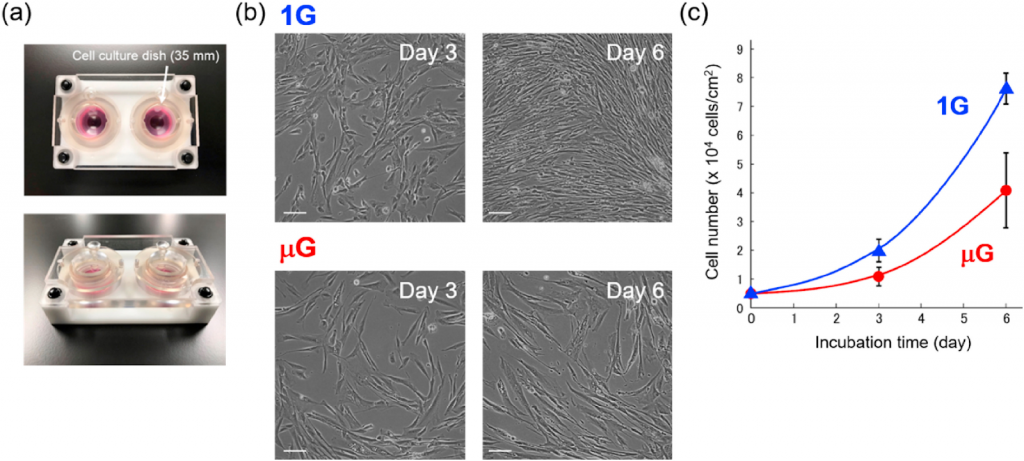Highlights:
- Resistance exercise alone isn’t enough to prevent age-related or microgravity-induced muscle loss.
- Aging and microgravity-related muscle loss stem from diminished muscle growth potential.
- Age-related and microgravity-induced muscle loss may share effective treatment options.
In space, although astronauts appear weightless, they still depend on their muscles to live. Whether in space or down here on Earth, we need our muscles to execute an array of vital functions from conscious movement to unconscious heartbeats and breathing. If we ever want to get to Mars or reach the outer edges of the solar system, we’re going to need healthy muscles. There’s just one problem: space travel appears to speed up the loss of muscle function and regenerative abilities.
As reported in Biochemical and Biophysical Research Communications, Takahashi and colleagues from Tokyo Women’s University in Japan showed that human muscle cells subjected to simulated microgravity show signs of aging, including diminished muscle regeneration. Their study explains why astronauts have trouble preventing muscle loss even with exercise. Utilizing this model of microgravity in a dish can help us better prepare to shoot for the stars by understanding the effects of space travel here on Earth.
Exercise Isn’t Enough for Muscle Regeneration in Space
As we venture away from the Earth’s surface and into space, there’s a good chance that the amount of gravity will decrease as long as we don’t come within the gravitational pull of a stellar or planetary object. That’s why gravity on the International Space Station (ISS), which orbits the earth, is about 90% of what it is here on the planet’s surface. The phenomenon of reduced gravity is called microgravity.
With this decrease in gravity, maintaining muscle mass becomes difficult. Astronauts can offset this somewhat with resistance exercise in space. However, even when exercising for several hours a day, astronauts still lose muscle. Interestingly, the elderly have the same problem; training is not enough to completely prevent muscle loss. Coincidence? Takahashi and colleagues show that it is not.
Bringing Microgravity Down to Earth
Much of our current understanding of microgravity’s effect on the living body comes from animal studies done on the ISS. However, due to the limitations of conducting these studies, researchers on earth have begun using gravity-control devices, which utilize rotational movements to simulate microgravity. So far, many of these studies have only been done on animals. Takahashi and colleagues are among the first to use a gravity-control device on human muscle cells.
Muscle regeneration involves generating new muscle cells in response to damage like damage caused by resistance exercise. Muscle regeneration prevents muscle loss by promoting muscle growth. In aged muscle, muscle regeneration is diminished, helping to explain why resistance exercise does not entirely prevent muscle loss in the elderly. The question is whether reduced muscle regeneration also explains why exercise is not enough for astronauts.
Microgravity Ages Muscle Cells
To study the effects of microgravity on muscle cells, Takahashi and colleagues compared human muscle cells grown under simulated microgravity to human muscle cells grown under normal gravity. They found that the muscle cells grown in microgravity reproduced (proliferated) about half as much as the normal cells. As muscle cell reproduction is a critical aspect of muscle regeneration, this lack of reproduction would suggest that microgravity inhibits muscle regeneration.

After removing the muscle cells from microgravity, simulating an astronaut coming home to Earth, Takahashi and colleagues found that the microgravity-affected muscle cells looked more like “old” muscle cells. Both the “old” cells, which regrew multiple times to mimic aging, and the microgravity-affected cells were bigger and had larger nuclei than the “young” cells, which were only grown once. The “old” and microgravity-affected cells also showed signs of permanent inactivation (senescence), which stops cells from reproducing and is what occurs typically in aged human cells.
When astronauts come back to Earth from space flight, they eventually recover their muscle mass. As described above, even after removing the muscle cells from microgravity, the signs of aging were not reversed. The authors point out that this is likely because new cells were not provided to the microgravity-affected cells. This is not what would happen in the human body, which would generate new cells. Therefore, astronauts likely recover upon returning to earth because muscle regeneration is restored.

Microgravity Reduces Muscle Regeneration
Muscle regeneration and development are very similar processes. In both cases, new muscle cells are generated and fuse to form mature muscle cells. Takahashi and colleagues looked at two proteins associated with normal muscle development and regeneration called Myf5 and desmin. The Japanese scientists found that both proteins were reduced in microgravity-affected muscle cells. In the “old” cells, Myf5 was essentially absent.
In addition, many of the microgravity-affected cells were unable to develop into mature muscle cells and, when they did, they were smaller than usual. Development into mature muscle cells is the final step in muscle regeneration and development. So, these findings indicate that microgravity-affected muscle cells regenerate less.
Shared Prospects for Treating Muscle Loss
Similar experiments on human muscle cells will have to be conducted on the ISS or another orbiting spacecraft with real-life microgravity. The authors state, “We must be mindful of the differences that exist between ground-based experiments and weightless conditions in space. The difference between real and simulated microgravity needs to be considered in future works.”
In addition, whole animal and human studies are needed to confirm that microgravity reduces muscle regeneration and accelerates aging. Importantly, these studies will help us better understand muscle regeneration itself. There are still important questions that need answers: how can we prevent or reverse the decline of muscle regeneration? So far, it seems that we can answer this, and there are prospects for a shared treatment for both age-related and microgravity-induced muscle loss.